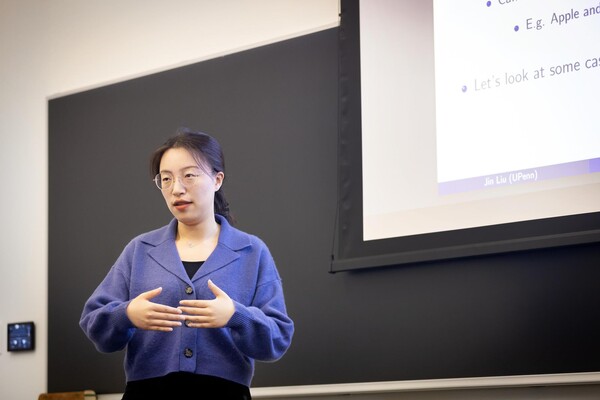
(From left) Doctoral student Hannah Yamagata, research assistant professor Kushol Gupta, and postdoctoral fellow Marshall Padilla holding 3D-printed models of nanoparticles.
(Image: Bella Ciervo)
At the microscopic level, lipid nanoparticles (LNPs)—the revolutionary drug delivery vehicles behind the COVID-19 vaccines—can face difficulty when attempting to deliver mRNA to cells. Optimizing the design and delivery of LNPs can greatly enhance their ability to deliver mRNA successfully, empowering cells with the disease-fighting instructions needed to transform medicine. Even when LNPs reach their target cells, the nanoparticles are typically captured by endosomes—tiny protective sacs within the cell.
“If the endosomal escape process doesn’t happen, LNPs become trapped and cannot deliver therapeutic cargo,” says Michael J. Mitchell, associate professor in Bioengineering at Penn’s School of Engineering and Applied Science. “They can make it all the way from a needle into the cell, but if they don’t open that final barrier, they’re useless.”
Several years ago, other researchers discovered that adding a branch to the end of LNPs’ normally linear lipid tails dramatically improved mRNA delivery. This discovery prompted Marshall Padilla, a postdoctoral fellow in the Mitchell Lab, to question if it could serve as the key to developing more effective lipids for mRNA delivery. One major challenge in making these improved lipids was the difficulty of creating branched ionizable lipids — key components of LNPs that change their charge to help them escape the endosome. These lipids are not commercially available in a branched form, so Padilla had to create them himself.
“The key issue was forming carbon-carbon bonds, which are notoriously difficult,” says Padilla. “I used a complex mix of lithium, copper and magnesium to make the reaction work.”
The result is a new class of lipids called branched endosomal disruptor (BEND) lipids. These unique, branched molecules help LNPs break through the endosomal membrane, making them more effective at delivering mRNA and gene-editing tools.
In a new study in Nature Communications, Mitchell, Padilla and their collaborators demonstrate that BEND lipids improve LNP delivery of mRNA and gene-editing tools, in some cases by as much as tenfold.
Read more at Penn Engineering Today.
Ian Scheffler

(From left) Doctoral student Hannah Yamagata, research assistant professor Kushol Gupta, and postdoctoral fellow Marshall Padilla holding 3D-printed models of nanoparticles.
(Image: Bella Ciervo)

Jin Liu, Penn’s newest economics faculty member, specializes in international trade.
nocred

nocred

nocred